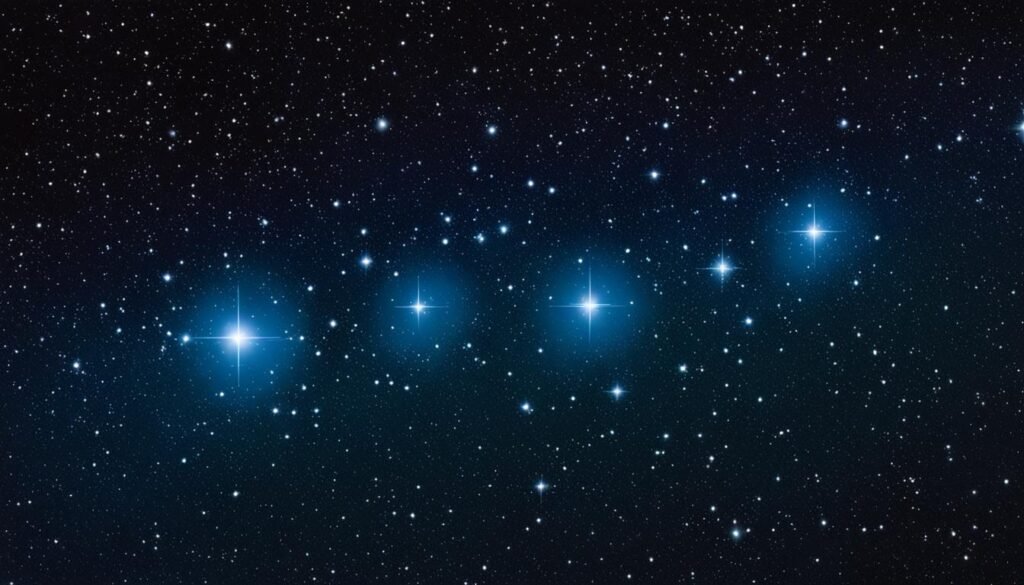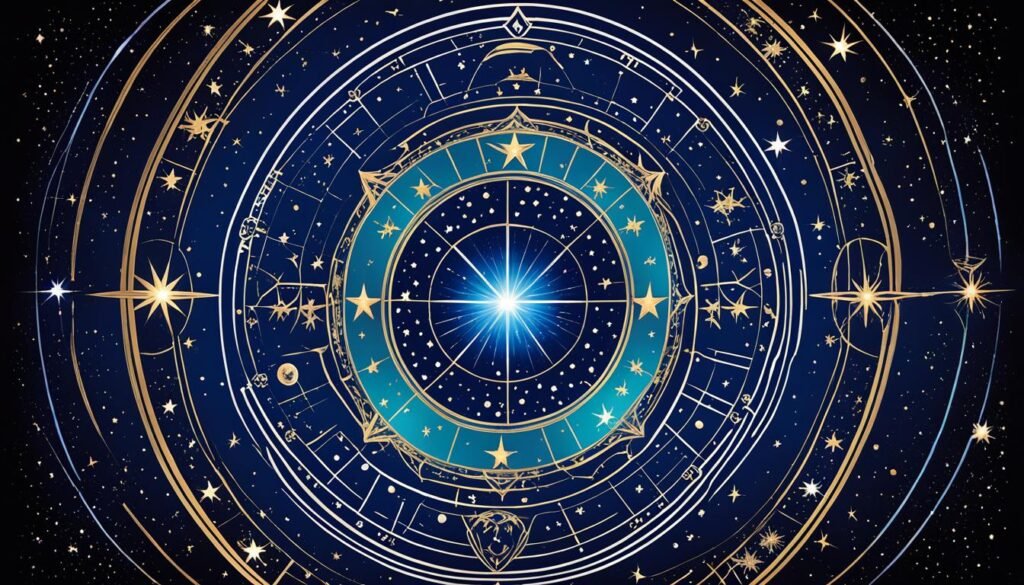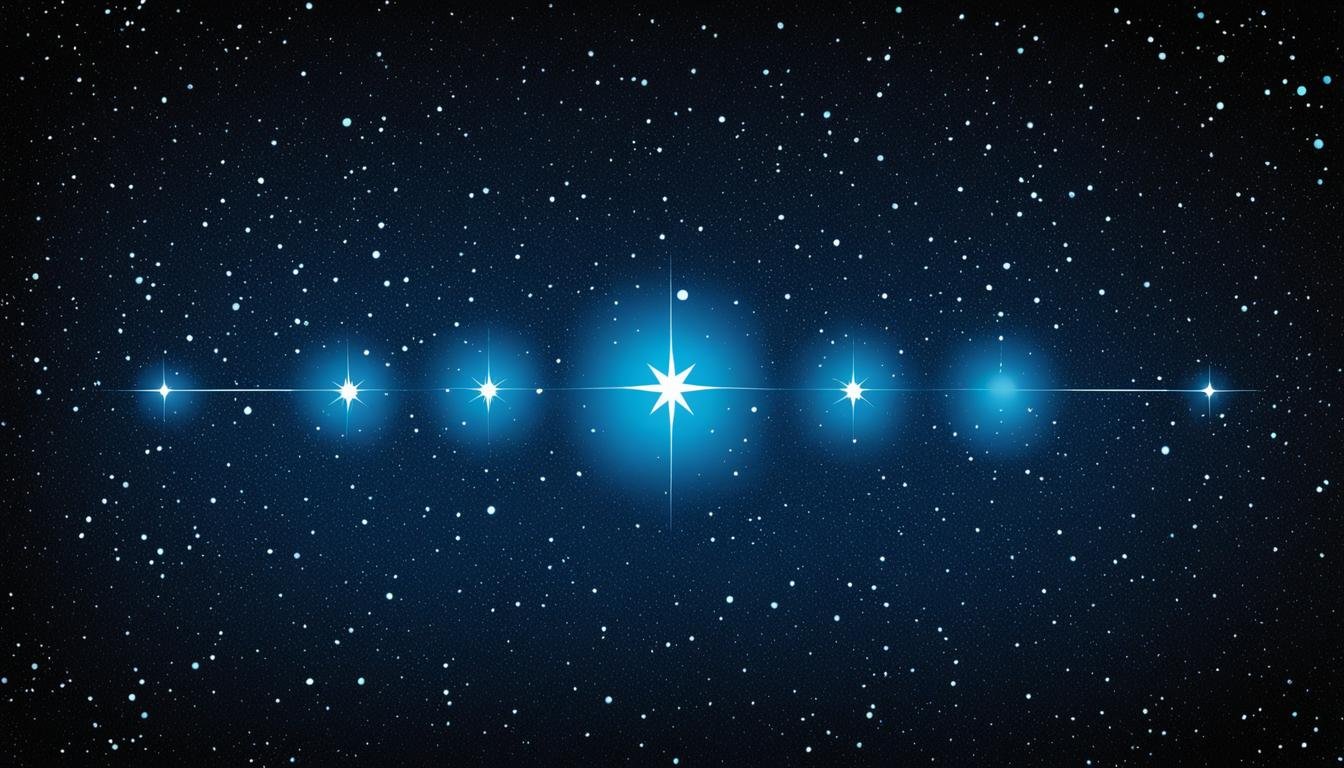When gazing upon the night sky, your eyes may be drawn to the Orion’s Belt asterism, one of the most prominent star formations that has captivated skywatchers for millennia. Nestled within the larger constellation Orion, this celestial belt features a stellar trio known for their astronomical beauty and alignment. The three bright stars that create the linear splendor of the star grouping Orion’s Belt—Alnitak, Alnilam, and Mintaka—serve as cosmic milestones that not only enhance the celestial panorama but also bridge the expanse between modern stargazing and ancient mythologies. Embarking on this cosmic journey unfolds a tale woven from the threads of starlight, deeply embedded in the tapestry of various cultures across history.
Key Takeaways
- Orion’s Belt asterism is a highly identifiable celestial feature in the night sky.
- Comprised of three bright stars, this straight line is a prominent star formation within the constellation Orion.
- Orion’s Belt serves as a gateway to understanding celestial navigation and sky mapping.
- The asterism’s individual stars—Alnitak, Alnilam, and Mintaka—each hold unique characteristics and contribute to the asterism’s overall brilliance.
- Orion’s Belt’s cultural significance is highlighted through its presence in mythological stories and its role as a navigational aid throughout history.
Discovering Orion’s Belt: Introduction to a Celestial Marvel
When you gaze up at the night sky, the Orion constellation often stands out, particularly due to the distinct star pattern Orion’s Belt. This recognizable line of stars, comprised of the bright trio Alnitak, Alnilam, and Mintaka, presents not just an astronomical treasure but also a rich tableau of history and myth.
Known by various names in different cultures, Orion’s Belt – also referred to as the “Three Kings” or “Three Marys” – captures the fascination of astronomers and stargazers alike. The way these three stars of Orion align so perfectly in a row makes for an arresting sight, playing a significant role in both scientific study and cultural lore.
The visibility of the Orion’s Belt varies with the seasons, an important aspect for anyone keen on observing this astral wonder. During the northern latitude winter months or the summer months in the Southern Hemisphere, the stars’ positioning becomes particularly prominent, offering a clear view of this stunning celestial marvel.
| Star Name | Description | Cultural Significance |
|---|---|---|
| Alnitak | Easternmost star, part of a multiple star system | Often associated with the “Girdle of Orion” in antiquity |
| Alnilam | Central and brightest, a blue supergiant and slightly variable star | Represents the ‘center jewel’ in various cultural interpretations |
| Mintaka | Westernmost and an eclipsing binary system | Known as one of the “Three Kings” following the eastern star in various myths |
As you take the time to look up and observe the Orion constellation, remember that you are connecting with a pattern observed by countless generations before you. The Orion’s Belt serves not only as a breathtaking fixture of our universe but as a bridge to past civilizations who also marveled at its splendor.
Mapping the Sky: Locating Orion’s Belt Asterism
The night sky is a canvas of celestial wonders, and amongst them, the Orion constellation serves as a guide to both novice and seasoned stargazers. Understanding when and where to look will enhance your experience, revealing the illustrious trio known as Orion’s Belt.
Best Times to View the Orion’s Constellation
For the best time to see Orion, your calendar should be marked from November through February if you’re positioned in the Northern Hemisphere. This period aligns with the crisp, clear winter nights that provide the most optimal conditions for stargazing. Specifically, in January around 9 pm, you’ll witness the star grouping at its most vibrant, as the alignment of stars making up the Belt are prominently on display.
Navigational Landmarks: From Northern to Southern Hemisphere
Sitting elegantly along the celestial equator, Orion’s Belt is visible from virtually any spot on Earth. If you find yourself under the Northern Hemisphere skies, turn your gaze toward the southwestern horizon to spot this prominent star formation. On the flip side, stargazers in the Southern Hemisphere should look northwest to catch the stellar alignment celebrating the celestial equator’s grandeur.
Observing the Celestial Belt Within Orion
The Orion constellation is often distinguished by its iconic hour-glass shape but make no mistake; the engaging trio of the Belt can often steal the show on their own. These three bright stars – aligned with each other across the cosmos – boast a luminous bluish glow. This captivating grouping, visible even without a telescope, are perfectly poised at the hunter’s waist, making them a prominent star formation impossible to overlook.
Whether you are an equatorial dweller or find yourself in the extremes of the hemispheres, the guide below will help ensure you catch this cosmic performance at its peak.
| Location | Best Time to View | Where to Look |
|---|---|---|
| Northern Hemisphere | November – February, around 9 pm in January | Southwestern sky |
| Southern Hemisphere | Summer months | Northwestern sky |
The Three Luminous Beacons: Stars of Orion’s Belt
Within the vibrant night sky, you can observe the Orion’s belt stars—a linear sequence of three stellar spectacles. These stars, Mintaka, Alnilam, and Alnitak, are not only essential for celestial navigation but also possess their own unique characteristics that make them standout jewels in our galaxy.

Mintaka, residing on the western end of Orion’s Belt, is a stellar powerhouse comprising multiple star systems. About 1,200 light-years away, Mintaka’s primary component, an eclipsing binary system, makes it a fascinating subject of study for astronomers. Alnilam, the luminary at the center of Orion’s Belt, gleams about 2,000 light-years from Earth. As a blue supergiant, Alnilam is the most luminous of the belt stars, though its light varies slightly as it is a mildly variable star. Alnitak, the eastern anchor of the belt, and approximately 1,260 light-years distant, is noteworthy for its classification as a triple star system, with its primary, Alnitak Aa, existing as one of the sky’s most resplendent class O supergiants.
| Star Name | Distance (light-years) | Star Type | Remarkable Features |
|---|---|---|---|
| Mintaka | 1,200 | Multiple Star System | Eclipsing binary primary component |
| Alnilam | 2,000 | Blue Supergiant | Brightest, mildly variable star |
| Alnitak | 1,260 | Class O Supergiant (Triple Star System) | Includes one of the brightest class O stars |
As you gaze up at the brilliance of the Orion’s belt stars, take a moment to consider the vast distances and monumental forces at play—elements that make the night sky not only a wonder to behold but also a rich tapestry woven with impressive celestial markers like Mintaka, Alnilam, and Alnitak.
Cosmic Significance: Orion’s Belt in Culture and History

The luminous trail of Orion’s Belt has not only adorned our night sky but has also etched a rich tapestry of stories and customs in the cultural consciousness of civilizations across the globe. The following sections delve into the extensive Orion’s Belt influence on cultural traditions and the mythological tales that these celestial beacons have inspired.
The Global Impact of Orion’s Belt Across Cultures
Throughout history, the three aligned stars of Orion’s Belt have been more than shimmering specks in the sky; they have symbolized hope, guidance, and the divine for many societies. The asterism’s presence in folklore and religious texts shows its deep-rooted impact on human culture, transcending timelines and geographies. Cultural traditions around the world have drawn from the imagery of the ‘belt’ to narrate their own regional stories and pass down knowledge through generations.
Mythological Tales and Names Inspired by the Celestial Belt
In mythology, Orion’s Belt has a myriad of identities. In Western tradition, these stars have been referred to as the Three Kings, guiding the wise men to Bethlehem, while other cultures know it as the Three Marys. Such iconic associations underscore the shared human fascination with these aligned stars and their power to inspire narratives that are both unique and universal.
| Cultural Reference | Nomenclature | Cultural Significance |
|---|---|---|
| Western Traditions | Three Kings | Symbols of guidance and wisdom, leading the Magi to the nativity scene. |
| South American Cultures | Three Marys | Represent the three biblical Marys, connected to the Christian faith and lore. |
| Egyptian Mythology | Osiris’ Belt | Associated with Osiris, the god of the afterlife, emphasizing the concept of rebirth and the eternal. |
| Norse Folklore | Freya’s Distaff | Linked to Freya, the Norse goddess of love and fate, manifesting cosmological storytelling. |
As you gaze up at the night sky, remember that the stars you are looking at are more than just points of light. They are part of our shared heritage, woven into the fabric of mythological tales inspired by Orion’s Belt, a testament to the enduring human spirit to find meaning amongst the stars.
Using Orion’s Belt Asterism as a Celestial Guide
For both amateur stargazers and seasoned astronomers alike, Orion’s Belt serves not merely as a distinctive formation in our night sky but also as a celestial compass of sorts. This reliable asterism within the Orion constellation offers a pathway to exploring adjacent cosmic wonders. As you learn to spot and interpret this asterism’s configuration, the sky’s expansive canvas unfolds, offering striking celestial objects and stellar territories waiting to be discovered.
Spotting the Adjacent Constellations
When you gaze up at the three aligned stars forming Orion’s Belt, know that they are the windows to a larger cosmic narrative. Flanking the asterism, to its northwest, is Betelgeuse, a red supergiant renowned for its brilliance and variable nature. To the southeast lies Rigel, a blue-white supergiant offering a brilliant contrast to Betelgeuse. Both of these stars are quintessential members of the Orion constellation stars and provide additional guidance for you to map out the celestial hunter’s storied form.
Tracing the Orion Nebula with Orion’s Belt as an Anchor
Dangling like a sword from Orion’s Belt, you’ll find the Orion Nebula, also known as Messier 42. This stellar nursery, visible to the naked eye under ideal conditions, emits a softly glowing red light against a darker backdrop, situated just below the alignment of the renowned belt. The nebula, part of Orion’s sword, contains a bustling region of star formation, and serves a reminder of the universe’s ever-changing nature—an awe-inspiring sight that anchors us to the foundations of stellar evolution.
Locating Other Prominent Stars and Asterisms via Orion
The strategic placement of Orion’s Belt in the night sky also helps connect you to other prominent stars and asterisms beyond the bounds of Orion. Extending the asterism’s line from Alnitak leads you to Sirius, the brightest star visible from Earth, while a line projected from Mintaka points towards Aldebaran, the vibrant eye of the Taurus constellation, and further on to the resplendent cluster known as the Pleiades. Each of these celestial objects is a testament to the Belt’s role as more than a mere collection of stars—it is a celestial guidebook, a roadmap to the heavens that invites your curiosity and promises to unlock the mysteries of the greater cosmos.
FAQ
What is the Orion’s Belt asterism and where is it located?
The Orion’s Belt asterism is a prominent star formation visible in the night sky within the constellation Orion. It consists of three bright stars—Alnitak, Alnilam, and Mintaka—aligned to form what looks like the celestial hunter’s belt in the larger pattern of the constellation.
How can I identify the Orion constellation and the Orion’s Belt asterism in the sky?
You can identify the Orion constellation by locating the three stars that form a straight and almost equidistant line—the Orion’s Belt asterism. These stars are generally bright and easy to spot in the night sky, especially during winter in the northern hemisphere and summer in the southern hemisphere.
When is the best time to see the Orion constellation and its belt?
The best time to observe the Orion constellation and its celestial belt is between November and February in the northern hemisphere, preferably around 9 pm in January. For those in the Southern Hemisphere, the constellation is more visible during the summer months.
From which parts of the world can Orion’s Belt be seen?
Being along the celestial equator, Orion’s Belt is visible from both the Northern and Southern Hemispheres. In the Northern Hemisphere, look to the southwestern sky, and in the Southern Hemisphere, check the northwestern sky.
Can Orion’s Belt help in locating other stars and constellations?
Yes, Orion’s Belt can serve as a guidepost for locating other celestial objects. Extending a line from Orion’s Belt towards Alnitak leads to Sirius, and drawing another line from Mintaka can direct you toward Aldebaran and the Pleiades. It also helps in finding nearby stars in the Orion constellation like Betelgeuse, Rigel, Bellatrix, and Saiph.
What makes the stars of Orion’s Belt stand out from other stars?
The stars of Orion’s Belt stand out due to their brightness, distinct blue hue, and their unique straight alignment which is easily distinguishable amidst other star patterns in the sky.
What are the cultural significances of Orion’s Belt?
Orion’s Belt holds significant roles in various cultural narratives and traditions, influenced by its visibility and prominence. It has been associated with mythology, navigation, and religion and referred to by names such as “Three Kings” and “Three Marys,” each bearing unique cultural stories and significance.
What mythological tales are inspired by the celestial belt of Orion?
Throughout history, various cultures have created mythological tales inspired by the stars of Orion’s Belt. These tales range from representing figures like the Three Wise Men to being associated with different deities and heroes in cultural folklore.
How can I find the Orion Nebula using the Orion’s Belt as an anchor?
To locate the Orion Nebula, look for the three dimmer stars just below the line of Orion’s Belt. These stars represent Orion’s sword, and the Orion Nebula can be identified in a direct line below the belt, observable as a fuzzy patch with a red hue.
Are there any navigational uses for Orion’s Belt?
Historically, Orion’s Belt has been used for navigational purposes due to its ease of identification and its position along the celestial equator, making it a reliable reference point for travelers and navigators.






